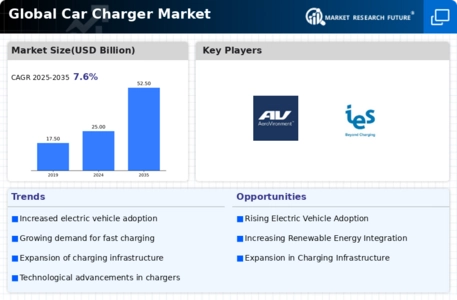Market Growth Projections
The Global Global Car Charger Market Industry is poised for substantial growth, with projections indicating a market size of 52.5 USD Billion by 2035. This growth trajectory is underpinned by a compound annual growth rate (CAGR) of 6.99% from 2025 to 2035. Such figures suggest a robust demand for car chargers as electric vehicle adoption accelerates globally. The market dynamics are influenced by various factors, including technological advancements, government regulations, and consumer preferences. As the industry evolves, stakeholders must remain agile to capitalize on emerging opportunities and address potential challenges in the charging infrastructure landscape.
Rising Electric Vehicle Adoption
The increasing adoption of electric vehicles (EVs) is a primary driver for the Global Global Car Charger Market Industry. As consumers and governments prioritize sustainable transportation, the demand for car chargers is surging. In 2024, the market is projected to reach 25.0 USD Billion, reflecting a growing need for charging infrastructure. Countries worldwide are implementing incentives and subsidies to promote EV usage, further propelling charger demand. For instance, the European Union aims to have at least 30 million electric cars on the road by 2030, necessitating a robust network of charging stations to support this transition.
Expansion of Charging Infrastructure
The expansion of charging infrastructure is vital for the growth of the Global Global Car Charger Market Industry. As more charging stations become available, consumer confidence in electric vehicles increases, leading to higher adoption rates. In 2024, the market is projected to reach 25.0 USD Billion, partly due to investments in infrastructure development. For example, partnerships between private companies and governments are facilitating the installation of charging stations in urban and rural areas alike. This widespread availability is essential for supporting the anticipated growth in electric vehicle sales and ensuring that consumers have convenient access to charging options.
Government Initiatives and Regulations
Government initiatives and regulations play a crucial role in shaping the Global Global Car Charger Market Industry. Many nations are setting ambitious targets for reducing carbon emissions, which often include mandates for EV adoption and the establishment of charging infrastructure. By 2035, the market is anticipated to grow to 52.5 USD Billion, driven by supportive policies. For instance, the United States has introduced tax credits for EV buyers and funding for charging station installations. Such measures not only stimulate market growth but also encourage manufacturers to innovate and expand their product offerings in response to regulatory demands.
Growing Consumer Awareness of Sustainability
The rising consumer awareness regarding sustainability is a significant driver for the Global Global Car Charger Market Industry. As individuals become more conscious of their environmental impact, the shift towards electric vehicles and the corresponding need for car chargers intensifies. This trend is reflected in the projected market growth, with estimates suggesting a compound annual growth rate (CAGR) of 6.99% from 2025 to 2035. Consumers are increasingly seeking eco-friendly alternatives, which drives demand for efficient charging solutions. Companies that align their products with sustainability goals are likely to gain a competitive edge in this evolving market.
Technological Advancements in Charging Solutions
Technological innovations in charging solutions are significantly influencing the Global Global Car Charger Market Industry. Developments such as fast charging technology and wireless charging systems enhance user convenience and reduce charging times. As of 2024, the market is expected to benefit from these advancements, with projections indicating a market size of 25.0 USD Billion. Companies are investing in research and development to create more efficient chargers that can cater to a wider range of electric vehicles. For example, ultra-fast chargers can provide up to 80% charge in just 30 minutes, making them increasingly appealing to consumers.













